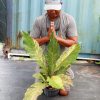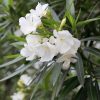Description
This Thai Ruby will fill others with Anthurium EnvyThe Thai Ruby Anthurium is a stunning plant that requires specific care to thrive. With proper attention, it can live for many years and produce beautiful blooms throughout the year. Here are some tips for caring for your Thai Ruby Anthurium.LightThe Thai Ruby Anthurium prefers moderate to bright indirect light. Direct sunlight can scorch its leaves and cause damage to the plant. Place your Anthurium in a location where it can receive bright light for several hours a day, but is shaded during the hottest parts of the day. If you notice that the leaves are turning yellow or brown, it may be an indication that the plant is getting too much direct sunlight. Move it to a location that receives less light or use a sheer curtain to filter the light.WaterThe Thai Ruby Anthurium requires consistent moisture but does not like to be overwatered. Water the plant thoroughly when the top inch of soil feels dry to the touch. Be sure to allow excess water to drain away from the pot, as standing water can cause root rot. It is important not to let the plant sit in water for an extended period. During the winter months, when the plant is not actively growing, it may require less frequent watering.HumidityThe Thai Ruby Anthurium is native to tropical climates and prefers a humid environment. Place a tray of water near the plant or use a humidifier to increase humidity levels around the plant. Another option is to place the plant on a bed of pebbles that are partially submerged in water. This creates a humid microclimate around the plant.TemperatureThe Thai Ruby Anthurium prefers temperatures between 60-80 degrees Fahrenheit. Avoid placing the plant near cold drafts or in areas with fluctuating temperatures. If the temperature drops below 60 degrees, the plant may suffer from cold damage.FertilizerThe Thai Ruby Anthurium benefits from regular fertilization during the growing season. Use a balanced fertilizer that is high in phosphorus to promote blooming. Apply fertilizer every two to four weeks during the growing season, following the package instructions. Avoid fertilizing the plant during the winter months when it is not actively growing.PruningPruning is an essential part of caring for the Thai Ruby Anthurium. Remove any yellow or damaged leaves as soon as you notice them. This helps to prevent the spread of disease and promotes healthy growth. You can also prune the plant to control its size and shape. Use sharp, clean shears to make a clean cut, and be sure not to remove more than 1/3 of the plant at a time.Pest and Disease ControlThe Thai Ruby Anthurium is relatively pest and disease-resistant, but it is still important to monitor the plant for any signs of infestation or disease. Common pests include spider mites, aphids, and mealybugs. If you notice any of these pests, isolate the plant and treat it with an appropriate insecticide or fungicide. Be sure to follow the package instructions and use a product that is safe for Anthuriums. Avoid using harsh chemicals that can damage the plant.





